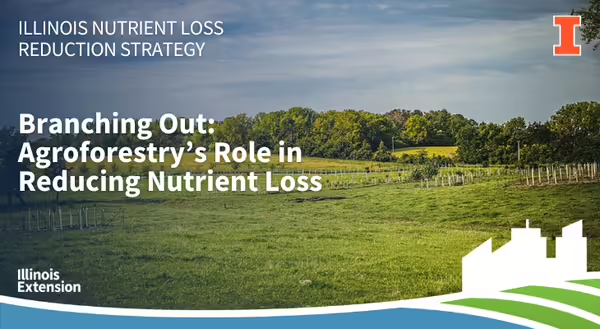
In Episode 73 of the Illinois Nutrient Loss Reduction Podcast, Nate Lawrence and MJ Oviatt from the Savanna Institute discuss how agroforestry practices like windbreaks, alley cropping, silvopasture, and riparian buffers can reduce nutrient loss and support farm resilience. These practices incorporate trees and shrubs into farm systems in ways that enhance water quality, soil health, and biodiversity, while also offering potential economic benefits.
Agroforestry in Practice
Agroforestry includes practices such as:
Each of these systems brings perennial vegetation into cropping or grazing systems, helping to keep soil and nutrients in place. On marginal land, such as land prone to erosion or frequent flooding, agroforestry can reduce input costs and protect surrounding water bodies while potentially providing an opportunity for income.
Demonstration sites in Illinois
MJ Oviatt, Illinois Agroforestry Educator, explained that the Savanna Institute operates three demonstration farms where producers can see these systems in action at educational events and workshops. In Monticello, a 35-acre site shows how timber rows can be integrated with corn and soybean rotations. The Hudson Farm, located near Urbana, is the largest agroforestry demonstration site in the United States. This 120-acre farm includes prairie strips, diverse alley cropping systems, and over a dozen windbreak designs. In addition, the Field's Restored site, located in Ogle County, demonstrates silvopasture with cattle, riparian buffers, and additional tree-crop integration.
Corn Belt Windbreak Project
Nate Lawrence, Ecosystem Scientist, discussed the Corn Belt Windbreak Project, which is a five-year study led by the Savanna Institute with partners at the University of Illinois and Iowa State University. The goal is to evaluate existing windbreaks and explore how they impact yields, nutrient runoff, and wildlife habitat. Farmers who participate will receive stipends and contribute to a growing body of research on windbreak effectiveness.
Reducing nutrient leaching
Lawrence explained that he and his team use lysimeters to measure nitrogen leaching in agroforestry systems. Early results show reduced nutrient movement into groundwater compared to other nearby conventional fields. Tree-based systems also provide year-round cover, filtering runoff, and keeping nutrients on the land.
Considering the economics
Oviatt acknowledged that adoption of agroforestry practices is often limited due to cost and concerns about removing land from production. However, she explained that these systems can make financial sense when used on acres that don’t yield well or when paired with other income sources like timber, nuts, or conservation payments. The Savanna Institute is studying how agroforestry can work economically and support both farmers and the environment.
Upcoming events
Oviatt encouraged producers and conservation professionals to attend upcoming events hosted by the Savanna Institute. In addition to their monthly tours in Urbana and Monticello, a one-day workshop, Trees for Bugs, Birds, and Bees, will be held on September 30, 2025, at the 4-H Memorial Camp near Monticello. All upcoming programs can be found on their events calendar.
To listen to the entire interview, go to Episode 73 of the Illinois Nutrient Loss Reduction Podcast.
About the authors
Rachel Curry is an Agriculture and Agribusiness Educator specializing in agriculture and watershed education, and she is part of the Illinois Extension's Nutrient Loss Reduction Strategy implementation team. She holds a B.A. in Environmental Studies from Knox College and an M.S. in Environmental Science and Soil Science from Iowa State University, focusing on soil fertility. Her work centers on education and outreach related to the Illinois Nutrient Loss Reduction Strategy, promoting agricultural conservation practices that reduce nutrient loss while enhancing water quality and soil health across Illinois.
Nicole Haverback serves as a Watershed Outreach Associate and is an Illinois Extension team member implementing the Nutrient Loss Reduction Strategy. She holds a B.S. in Agricultural and Rural Policy Studies from Iowa State University. In her role, Nicole coordinates watershed management and planning efforts aimed at reducing nutrient losses in priority areas, offers expertise on best management practices to minimize nutrient loss, and leads outreach initiatives promoting agricultural conservation practices outlined in the Illinois Nutrient Loss Reduction Strategy.
About the blog
At Illinois Extension, we’re working to improve water quality at home and downstream. Every month, our Watershed Outreach Associates will bring you stories highlighting agricultural conservation practices, current research projects and results, and from the field farmer interviews. The Nutrient Loss Reduction blog covers conservation practices recommended by the Illinois Nutrient Loss Reduction Strategy, timely updates, farm safety, and new decision tools to help farmers and producers reduce the nutrients leaving their fields.